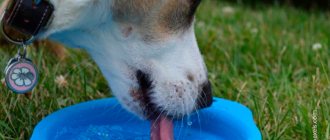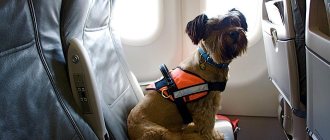Make sure your dog is lost
A frightened, intense look, the whole posture indicates uncertainty (lowered tail, flattened ears, creeping uneven movements). The dog rushes along the street, now trying to sniff tracks, now looking into the faces of passers-by. The behavior is generally inappropriate; it is clear that the dog is fussing. The fur is tousled. If a dog has spent at least a day on the street, then the fur is simply dirty. If you talk to a lost dog, it is clearly torn between the desire to accept the help of a stranger and the desire to continue the search for its lost owner.
A lost animal behaves on the street in a special way: it is restless, rushes from side to side in obvious searches, or runs away from people, or, conversely, clings to crowded places and looks into the eyes in search of sympathy and alms, or lies apathetically, having already lost any hope, and almost does not react to the environment. If the dog’s actions on the street are confident and purposeful, most likely the animal has already adapted to the environment and does not need your help too much.
Should you take your dog to the vet?
If you take a dog from the street, what should you do first? Show it to the veterinarian and get its blood tested. Distemper, enteritis, babesiosis - this is not the entire list of dangerous diseases that a dog can pick up. There is a vaccine for them, but you can’t inject it right away. First you need to get rid of worms, otherwise vaccination will be ineffective.
If a blood test reveals an infection, your doctor will prescribe treatment to help save your pet. If you pick up an obviously sick puppy, veterinary care should be provided immediately. Any hour of delay could cost him his life.
The doctor should also examine the stray puppy to make sure there are no ticks. Even if the arthropod is not a carrier of infection, it irritates the pet’s skin and can cause inflammation. Important! A tick infected with babesiosis or another infection could bite the dog and fall off earlier. Therefore, a blood test is required.
To prevent the development of infection, the doctor can inject the dog with Gamavit. This remedy increases the body's defenses and helps fight disease.
What to do next?
If the dog has recently gotten lost, then be sure to stand still with it for 10-15 minutes, wait - suddenly the out of breath owner will appear.
If the dog has been lost for a long time or the owner has not appeared on the horizon, then take it on a leash (any rope, scarf, etc. will do) and give the command “let’s go home.” It is possible that the dog knows where his home is and will lead you there.
If a miracle does not happen, and you are ready to deal with the fate of this animal, then take it to you. At home in a calm environment, carefully examine the dog.
What to feed a puppy from the street
The pet must be fed 3 times a day if it is 6 months old. If he is younger (from 4 to 6 months), the dog should be given food 4 times a day every 5-6 hours. If the baby appears to be 2-3 months old, feed him 5 times a day.
Buy your puppy a bowl that is not very deep, preferably made of stainless steel or high-quality plastic. Cheap containers may contain harmful substances that can poison the baby. Provide your dog with constant access to water.
When feeding, follow these rules:
- A dog is a carnivore and needs meat. Raw beef and calf are especially beneficial for him. To kill worms, harmful bacteria, freeze the meat for several days. Give your dog an anthelmintic once a quarter.
- Give chicken eggs 2-3 times a week. Wash them in hot water first to prevent salmonella from getting inside the shell.
- Don't forget to give offal - heart, liver, lungs, kidneys.
- Porridges are allowed, but in limited quantities. Remember that barley and oatmeal have a laxative effect.
- Boiled fish containing omega-3 fatty acids is beneficial for dogs. Remove the bones from the fish before giving it to your puppy.
- The dog digests vegetables and fruits well (carrots, cucumbers, tomatoes, beets). Before giving them to your pet, grind them on a grater.
Dry food can be given no earlier than 3 months. Give preference to super premium and holistic food. Never buy an economy class product (Pedigree, Woof). It is forbidden to mix dry food with natural food.
What not to give to a puppy
The food should not be hot, otherwise the dog may burn the oral mucosa. Sweets, fatty, fried foods, pickled and peppered foods are prohibited. Do not give milk to your dog - it is poorly digested and diarrhea is possible. Do not feed your dog long bones. They can pierce the stomach and intestines.
Examine the dog
- The mark is located on the inside of the ears or in the groin. Contains a set of several Russian or English letters and numbers. Try to disassemble it correctly. If the brand is difficult to read, shave the fur in this area and wipe the skin with alcohol, then it will be easier to read the number. Write down all possible interpretations of the number. Next, look for it in the stamp databases:
- The address holder is a small metal capsule on the collar. The capsule needs to be untwisted; it contains a piece of paper with the dog owner’s contact information.
- Phone number on the collar. It may be written on the inside of the collar, so remove the collar and check from all sides.
Basic recommendations for caring for a homeless puppy
On the very first day, buy drops against fleas and ticks and anthelmintic drugs at the pet store, taking into account the weight and age of the puppy (at least approximately).
The next day after bathing, if fleas continue to bother the puppy, you can drop insecticides onto the withers. If the dog does not itch, it is better to wait 3 days after bathing and then apply drops (as recommended by the instructions). Then the pet should not be soaked in water or bathed for 3 days.
If you adopted a dog from the street, give it an anthelmintic the next morning. The second time the parasites must be driven away after 10-14 days. After this you can vaccinate. The dog should not be allowed outside before the injection. After the injection there is a 10-day quarantine. To prevent puddles in the house, train your dog to use a diaper and a litter tray.
To prevent your puppy from getting bored and chewing the furniture, buy toys. Choose products made from good material. Ignore cheap toys. They can be toxic, and the dog will be poisoned.
If you work and have no one to look after your pet, buy him a spacious cage. Put a bed and toys there. Select an area for the diaper. Here he will sit in your absence and will not spoil anything.
Post an ad about a found dog
Be sure to include a photo. The photograph must be of high quality. To do this, it is enough to take the dog outside during daylight hours, tie it to any tree and photograph it from all sides. Photos taken in a dark apartment, where only two glowing eyes are visible from the flash, will not help you in finding the owners.
Post complete information about your dog on the following websites:
Please provide all available information:
- breed
- floor
- color, appearance
- special features of a dog
- approximate age
- the place where you found her
- add a photo
Don't forget to leave your contacts!
If the dog is clearly purebred, contact clubs that specialize in that breed. Perhaps they can help you find owners.
Print and post “Dog Found!” . Place them at bus stops and in public dog walking areas (parks, dog parks). Unfortunately, advertisements are often torn down, so you will have to post them several times.
Talk to the dog owners you meet on your walk, tell them about your find and that you are looking for owners. Leave them your coordinates. You can print small flyers with information about the found dog and your phone numbers.
If the owners have not been found, then you have 2 options:
- Find new owners. The principle of searching for new owners is the same as described above - the Internet, newspapers;
- Keep the dog.
Why can't you find someone who could help the stray four-legged?
It should be understood that there is no point in turning to someone for help if the four-legged animal is seriously injured or is very small. In this case, time goes by hours or even minutes. Saving a life is the main task of anyone who encounters an unfortunate animal on their way. There is no need to think that a tiny puppy or kitten or a crippled animal can survive on its own. Rare organizations and compassionate people take care of stray four-legged animals in the CIS. While saving the next sufferer, they also think about where to put him and where to find funds for him. Therefore, they are in no hurry to help, ignoring every new request.
To understand why these people do this, you need to realize that they usually have hundreds of pets. And each requires a lot of money, as well as, in general, time. Four-legged rescuers are making efforts to somehow pull out those they already care for. Each new animal is a real burden for them. Few people understand this. People don't realize that it's easier for everyone to take care of one cat or dog. Than one about hundreds or thousands of pets.
For example, Valentina Silich cannot refuse those who bring animals to her. Therefore, she found herself in a situation where the neighbors did everything to evict her shelter through the courts. She has rescued over 3,000 dogs and cats. But she now has 1,000 animals left. She collects funds for them everywhere, begging people for pennies. And when things get really tough for her, she takes out another loan. Anyone who brought a four-legged animal to her could take care of it themselves. An irresponsible person would not become poor if he treated and fed his pet. But for rescuers like Valentina Silich, every day is a struggle for survival.
Other people - imaginary animal rights activists - simply make money by describing a sick or injured animal online. They may not delve into his situation at all; many have not even seen those victims of civilization that they write about. After all, these people collect money into their accounts for their own needs. No one controls such “animal defenders,” but they create large communities on social networks, flaunting incomplete reports. After all, none of them provide the public with bank statements showing the real amounts received into their accounts. And such businessmen can be found on almost every second page supposedly dedicated to saving animals.
There are also people who know what to do with a found animal. They can respond to a request to help an animal and some of them even come to pick up the victim and take him to the clinic. But most volunteers take care of the four-legged animal as long as they can raise money for it. We are, of course, not talking about funds that should be spent on the needs of a dog or cat, but about money that helps dishonest people to be prosperous. As soon as an animal ceases to be of interest to the public, it ends up on the street. Moreover, the curator is not interested in what condition it is in. Your pet may be suffering from pain, injury, or illness. But if there is no money for it, the “volunteer” doesn’t care about the four-legged animal.
Still, the best option is when the finder supervises the found animal. In this case, the person will make every effort to ensure that the four-legged animal recovers quickly and ends up in good conditions with responsible people. Finding owners for an animal that has suffered enough is not so difficult both in the CIS and abroad. There are German and American sites on the Internet where you can post an ad, even while in Russia. This way, a rescued homeless animal will find better conditions for existence.
Shelter and foster care: salvation or death?
If you are sure that the dog has no owners, or while you are looking for them, the dog can be placed in temporary foster care. This could be a hotel for dogs, a private foster home (that is, a temporary shelter for dogs in a private apartment, a list of foster homes is easy to find). Also, at many veterinary clinics there are hospitals - hotels, where, by agreement, they can shelter an animal for a fee.
“The difference between hotels and private foster care is that in a hotel all the conditions of your ward’s stay will be specified in the contract; going to a private foster care facility is a matter of agreement and control,” explains
Call the appropriate service
Legally, you should contact animal control about your missing dog. Local laws usually require a certain period of time for a pet to be held in a shelter before a stray dog can be rehomed or euthanized. This period can range from five days to two weeks depending on local legislation.
The shelter period gives owners the opportunity to reclaim lost dogs. Due to overcrowding, you can take care of the pet yourself, but do not stop trying to find the owner. If the owner still cannot be found, you can inform animal control that you want to take the dog after the waiting period is completed.
How to recognize old owners
Pretty soon your phone will be red with calls from those who have ever lost a similar pet. You should not give your dog to the first person who dials your number. First make sure the dog really belongs to him. Here are some tips to help you distinguish the real owner from the scammer:
1. Ask the callers what their dog’s name is. Find out which affectionate nicknames he responds to most readily. A real owner will tell you a bunch of details from the pet’s life, remember special signs (scar or spot) and talk about the most characteristic behavioral features.
2. Ask to send photos of the dog in which it is depicted at different ages. Every owner has a hefty dossier of dog photos stored on his computer and phone. These don't have to be staged photos. Much more valuable is a photo of a dog sleeping sweetly on the sofa or fooling around in an embrace with its owner. The main thing is that the dog must be clearly visible in the picture. Muddy and dark photographs, in which only a silhouette can be guessed, are not suitable for identification.
3 It would be nice to come to visit those who introduce themselves as the host. The apartment in which the animal recently lived contains traces of its presence - wool on carpets and sofas (yes, it still remains, no matter how you clean it), toys with teeth marks, a dog mattress, a worn leash or muzzle.
4. The main stage of verification is meeting people with your foundling . Carefully observe the dog’s reaction - is he happy to meet you, does he recognize those who came, does he show aggression or fear towards them.
Security measures
If you have found a dog, be especially attentive when possible owners call you. Dogs are often used by beggars, and purebred animals are resold. To check whether the real owner of the animal has actually contacted you, you can do the following:
- Ask to send several photos of your pet;
- Ask to name its distinctive features;
- Find out the dog's name and see if the animal responds to it.
In some cases, finding the owner can be difficult. And sometimes the owners themselves deliberately leave their pet to the mercy of fate, which is why it is so important not to pass by a defenseless animal that is in such need of help.
Photos: Collection/iStock











